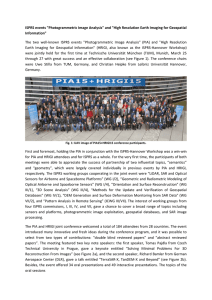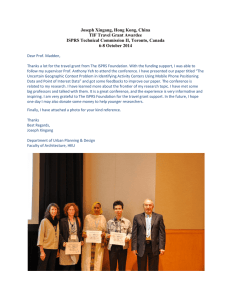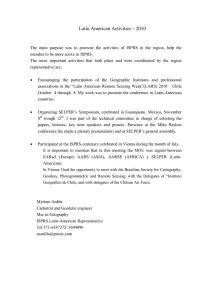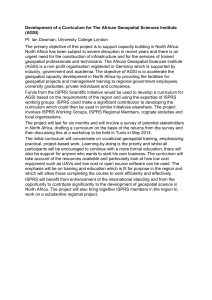Photogrammetric Image Analysis (PIA) & High Resolution Earth Imaging for
advertisement
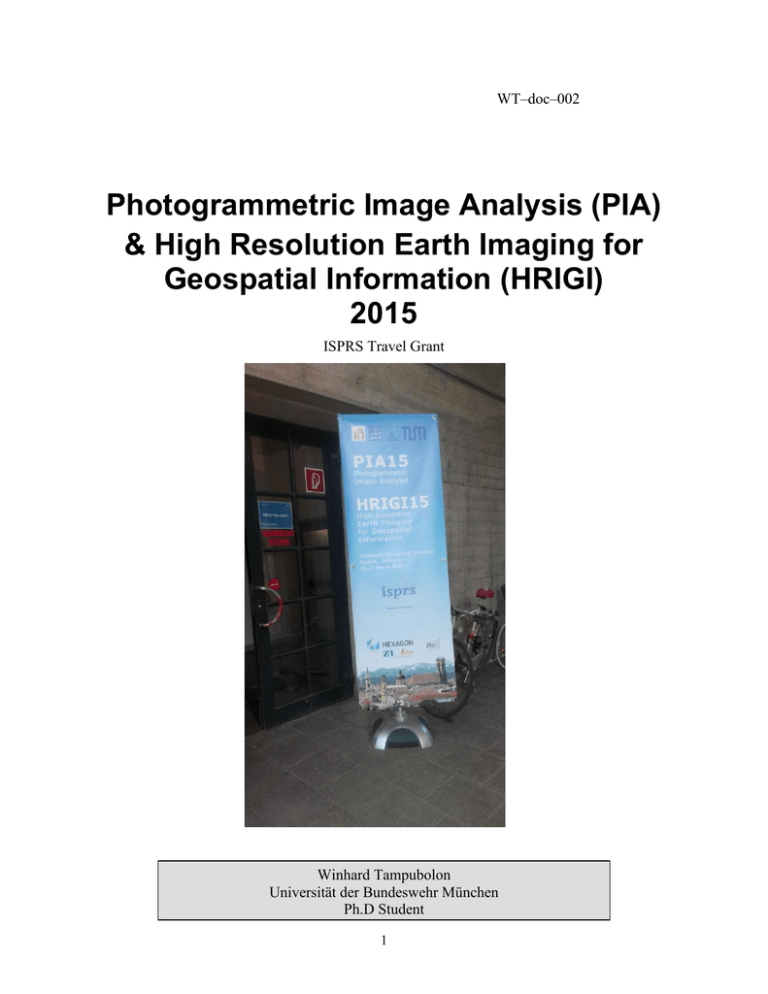
WT–doc–002 Photogrammetric Image Analysis (PIA) & High Resolution Earth Imaging for Geospatial Information (HRIGI) 2015 ISPRS Travel Grant Winhard Tampubolon Universität der Bundeswehr München Ph.D Student 1 Table of Contents 1. Introduction to PIA & HRIGI 2015 ........................................................................... 3 1.1. 1.2. 2. Participants ................................................................................................................... 3 2.1. 2.2. 3. Attendees .................................................................................................................................... 3 Sponsors...................................................................................................................................... 3 Activities ........................................................................................................................ 4 3.1. 3.2. 3.3. 4. Oral and Poster Session .............................................................................................................. 4 Keynote Session ......................................................................................................................... 4 Networking and Socialization..................................................................................................... 5 Publications................................................................................................................... 6 4.1. 4.2. 5. Scope of works ........................................................................................................................... 3 Objectives ................................................................................................................................... 3 Annals publications .................................................................................................................... 6 Archives publications ................................................................................................................. 6 Closing Remarks .......................................................................................................... 7 2 1. Introduction to PIA & HRIGI 2015 Photogrammetric Image Analysis (PIA) is a biannual congress, starting in 2003 with the concentration on the automatic exploitation of the image content. Hereafter, High Resolution Earth Imaging for Geospatial Information (HRIGI) or called Hannover Workshop was starting in 2007 with the focus on the geometric processing of aerial and in particular of space imagery. The idea to join these two conferences is of course a special interest for establishing the consistency between content and accuracy of space borne imageries. This joint event is designed to meet the needs of photogrammetrists and scientists from all levels. At that time was jointly steered by the program committees to establish an environment that will establish the scientific atmosphere in Remote Sensing and Very High Resolution Satellite (VHRS) Imagery development. To meet these goals, PIA/HRIGI provides further development status of a processing platform, and a set of scientific principles that organizes attendees into professional working group based on the ISPRS benchmark. 1.1. Scope of works This conference is an integral part of ISPRS activities and its approach can be adopted for scientific communities. The joint event addresses experts from research, government, and private industry. It consists of high quality papers, and provides an international forum for discussion of leading research and technological developments as well as applications in the field. Mainly each topic of this conference has a strong connection to: 1.2. Small satellites and satellite constellation VHRS imageries utilization for Mapping UAVs and alternative platforms Hyperspectral imaging 3D object extraction Rapid mapping for environmental applications and disaster management etc. Objectives The primary goal of this joint symposium is to seek, exploit and deepen the synergies between geometry and semantics, and to give the two scientific communities the possibility to discuss with and to learn from each other. 2. Participants 2.1. Attendees This joint PIA/HRIGI 2015 conference was attended by 176 attendees (Figure 1) from around the globe including United States, Australia, Brazil, India, Pakistan mostly from European countries (Germany, Switzerland, Austria, Sweden, Finland, UK, etc.). 2.2. Sponsors This conference was sponsored by some companies working on the sensor development as well as the geospatial processing platform: 3 1. Hexagon Geosystem (ZI Imaging, Leica Geosystems) 2. PIX4D 3. Activities 3.1. Oral and Poster Session Oral and Poster provided a set of presentations that supports a broad scope of scientific research activities, including the geoinformatics collaborations, space borne data improvement, applied mathematics in VHRS data processing, 3 D engineering, and computer sciences. Figure 1. The Congress Participants PIA/HRIGI continued to provide a platform for research activities that deploy and extend advanced distributed computing technologies in the photogrammetry and geoinformatics areas with direct implementation to the mapping purpose. 3.2. Keynote Session All participants greatly got benefit from the keynote speaker, especially to get an idea about what current status of photogrammetric and spaceborne technologies. In specific, it is interesting to know that TerraSAR-X/TanDEM-X can provide “2 cm” or “20 cents euro coin” accuracy as presented by the last keynote speaker i.e. Prof.Richard Bamler from DLR (Figure 2). 4 Figure 2. Last Keynote Speech about TerraSAR-X / TanDEM-X 3.3. Networking and Socialization Networking environment has been set from the first day of the conference directly after the second poster session in what so called “Ice Breaker” session. At this session, the attendees can exchange their idea as well as establish the good networking connection in the future. The Master Class on the second day of the conference from the mapping industry (Hexagon) about “sensors evolution to the solutions” brought mapping scientists and computer scientists together to provide a new idea for the engagement of students, faculty and researchers in learning the latest sensor development status, applying it to their approach and contributing to its future development. Immediately after the Master Class, the participants have been facilitated by the sponsor to enjoy cultural dinner session at the famous Münchner Kunstlerhaus (Figure 3). 5 Figure 3 Gala dinner in Münchner Künstlerhaus 4. Publications 4.1. Annals publications This joint ISPRS conference provided 38 annals which can be accessed immediately after the symposium with a concentration on 3D feature extraction, new approach and algorithm in the Spaceborne data as well as Airborne data processing. 4.2. Archives publications In parallel, there are 42 archives publications with a topic concentration ranging from space borne technologies, point cloud data processing and mapping purpose. The topic about “Analysis of RADAR and Optical Space Borne Data for Large Scale Topographical Mapping” has been presented at the first conference day (http://www.int-arch-photogramm-remote-sens-spatial-infsci.net/XL-3-W2/235/2015/isprsarchives-XL-3-W2-235-2015.pdf). 6 5. Closing Remarks I would like to say thank you to the ISPRS Foundation for supporting my presence and participation at PIA/HRIGI 2015 in Munich (Figure 4). PIA/HRIGI 2015 was an interesting conference which can establish the collaboration and exchange idea in the photogrammetry and geospatial aspect with the newly technology development status both in the sensors as well as in the processing platform site. The opportunity to deliver poster presentation of my research paper exposing the role of RADAR and Optical Space Borne data for Large Scale Topographical Mapping in Indonesia was really a good opportunity in order to get some inputs for the future improvement. As a suggestion it would be good if the waiver of symposium registration fee can be provided as a helpful support for the travel grantees in the future, especially for student participants. Figure 4 ISPRS Travel Grant Awards 7
